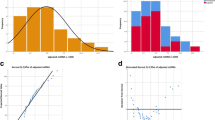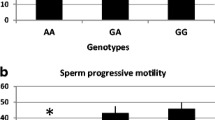Abstract
Purpose
To explore whether it is possible to predict the number and quality of the embryo using a few particular hTERT SNPs.
Methods
We included 997 Han Chinese women who were genetically unrelated and underwent assisted reproduction using IVF from September 2014 to December 2015. DNA was genotyped by using TaqMan real-time quantitative PCR.
Results
Among the 997 patients, individuals with the CC genotype of rs2075786 had a significantly lower number of good-quality embryos than those with the TT+TC genotypes. Compared with the CT+CC genotype carriers, patients carrying the TT genotype of rs2853677 had a significantly lower number of oocytes retrieved, mature oocytes and available embryos. Among the 750 patients aged ≤ 35 years, individuals with the AA+AG genotypes of rs2853691 had a significantly higher number of good-quality embryos than those with the GG genotype. The haplotype analysis showed that the TTTG (rs2853672/rs2853669/rs2735940/rs2736108) haplotype was more likely to lead to more than three good-quality embryos in patients aged ≤ 35 years.
Conclusions
Our study suggests that the hTERT SNP is associated with IVF outcomes.

Similar content being viewed by others
References
Jirge PR. Poor ovarian reserve. J Hum Reprod Sci. 2016;9:63–9. https://doi.org/10.4103/0974-1208.183514.
Amer Coll Obstetricians; Practice Comm Amer Soc Reprod Med. Female age-related fertility decline. Fertil Steril. 2014;101(3):633–4. https://doi.org/10.1016/j.fertnstert.2013.12.032.
Fang T, Su Z, Wang L, Yuan P, Li R, Ouyang N, et al. Predictive value of age-specific FSH levels for IVF-ET outcome in women with normal ovarian function. Reprod Biol Endocrinol. 2015;13:63. https://doi.org/10.1186/s12958-015-0056-6.
Chronowska E. Regulation of telomerase activity in ovarian granulosa cells. Indian J Exp Biol. 2012;50:595–601.
Townsley DM, Dumitriu B, Liu D, Biancotto A, Weinstein B, Chen C, et al. Danazol treatment for telomere diseases. N Engl J Med. 2016;374:1922–31. https://doi.org/10.1056/NEJMoa1515319.
Schmidt JC, Cech TR. Human telomerase: biogenesis, trafficking, recruitment, and activation. Genes Dev. 2015;29:1095–105. https://doi.org/10.1101/gad.263863.115.
Wang W, Chen H, Li R, Ouyang N, Chen J, Huang L, et al. Telomerase activity is more significant for predicting the outcome of IVF treatment than telomere length in granulosa cells. Reproduction. 2014;147:649–57. https://doi.org/10.1530/REP-13-0223.
Chen H, Wang W, Mo Y, Ma Y, Ouyang N, Li R, et al. Women with high telomerase activity in luteinised granulosa cells have a higher pregnancy rate during in vitro fertilisation treatment. J Assist Reprod Genet. 2011;28:797–807. https://doi.org/10.1007/s10815-011-9600-2.
Greider CW, Blackburn EH. The telomere terminal transferase of Tetrahymena is a ribonucleoprotein enzyme with two kinds of primer specificity. Cell. 1987;51:887–98. https://doi.org/10.1016/0092-8674(87)90576-9.
Liu JP, Li H. Telomerase in the ovary. Reproduction. 2010;140(2):215–22. https://doi.org/10.1530/REP-10-0008.
Bodnar AG, Ouellette M, Frolkis M, Holt SE, Chiu CP, Morin GB, et al. Extension of life-span by introduction of telomerase into normal human cells. Science. 1998;279:349–52. https://doi.org/10.1126/science.279.5349.349.
Lee J, Sung YH, Cheong C, Choi YS, Jeon HK, Sun W, et al. TERT promotes cellular and organismal survival independently of telomerase activity. Oncogene. 2008;27:3754–60. https://doi.org/10.1038/sj.onc.1211037.
Grossmann M. Danazol treatment for telomere diseases. N Engl J Med. 2016;375:1095–6. https://doi.org/10.1056/NEJMc1607752#SA1.
Melin BS, Nordfjall K, Andersson U, Roos G. hTERT cancer risk genotypes are associated with telomere length. Genet Epidemiol. 2012;36:368–72. https://doi.org/10.1002/gepi.21630.
Choi BJ, Yoon JH, Kim O, Choi WS, Nam SW, Lee JY, et al. Influence of the hTERT rs2736100 polymorphism on telomere length in gastric cancer. World J Gastroenterol. 2015;21:9328–36. https://doi.org/10.3748/wjg.v21.i31.9328.
Zhang W, Chen Y, Yang X, Fan J, Mi X, Wang J, et al. Functional haplotypes of the hTERT gene, leukocyte telomere length shortening, and the risk of peripheral arterial disease. PLoS One. 2012;7:e47029. https://doi.org/10.1371/journal.pone.0047029.
Yan L, Wu S, Zhang S, Ji G, Gu A. Genetic variants in telomerase reverse transcriptase (TERT) and telomerase-associated protein 1 (TEP1) and the risk of male infertility. Gene. 2014;534:139–43. https://doi.org/10.1016/j.gene.2013.11.008.
Whitaker L, Critchley HO. Abnormal uterine bleeding. Best Pract Res Clin Obstet Gynaecol. 2016;34:54–65. https://doi.org/10.1016/j.bpobgyn.2015.11.012.
Balaban B, Brison D, Calderon G, Catt J, Conaghan J, Cowan L, et al. The Istanbul consensus workshop on embryo assessment: proceedings of an expert meeting. Hum Reprod. 2011;26:1270–83. https://doi.org/10.1093/humrep/der037.
Misiti S, Nanni S, Fontemaggi G, Cong YS, Wen J, Hirte HW, et al. Induction of hTERT expression and telomerase activity by estrogens in human ovary epithelium cells. Mol Cell Biol. 2000;20:3764–71. https://doi.org/10.1128/MCB.20.11.3764-3771.2000.
Lee HW, Blasco MA, Gottlieb GJ, Horner JW II, Greider CW, DePinho RA. Essential role of mouse telomerase in highly proliferative organs. Nature. 1998;392:569–74. https://doi.org/10.1038/33345.
Shay JW, Zou Y, Hiyama E, Wright WE. Telomerase and cancer. Hum Mol Genet. 2001;10:677–85. https://doi.org/10.1093/hmg/10.7.677.
Nakayama J, Tahara H, Tahara E, Saito M, Ito K, Nakamura H, et al. Telomerase activation by hTRT in human normal fibroblasts and hepatocellular carcinomas. Nat Genet. 1998;18:65–8. https://doi.org/10.1038/ng0198-65.
Kim NW, Piatyszek MA, Prowse KR, Harley CB, West MD, Ho PL, et al. Specific association of human telomerase activity with immortal cells and cancer. Science. 1994;266:2011–5. https://doi.org/10.1126/science.7605428.
Wright WE, Piatyszek MA, Rainey WE, Byrd W, Shay JW. Telomerase activity in human germline and embryonic tissues and cells. Dev Genet. 1996;18:173–9. https://doi.org/10.1002/(SICI)1520-6408(1996)18:2<173::AID-DVG10>3.0.CO;2-3.
Ozturk S, Sozen B, Demir N. Telomere length and telomerase activity during oocyte maturation and early embryo development in mammalian species. Mol Hum Reprod. 2014;20(1):15–30. https://doi.org/10.1093/molehr/gat055.
Bellido F, Guinó E, Jagmohanchangur S, Seguí N, Pineda M, Navarro M, et al. Genetic variant in the telomerase gene modifies cancer risk in Lynch syndrome. Eur J Hum Genet. 2013;21(5):511–6. https://doi.org/10.1038/ejhg.2012.204.
Li X, Xu X, Fang J, Wang L, Mu Y, Zhang P, et al. Rs2853677 modulates Snail1 binding to the TERT enhancer and affects lung adenocarcinoma susceptibility[J]. Oncotarget. 2016;7(25):37825–38. https://doi.org/10.18632/oncotarget.9339.
Acknowledgements
The authors would like to thank all of the research workers who contributed to this study. We thank Professor Yiming Wang, a senior geneticist, for the genetics advice and Professor Caixia Li, an advanced statistician, for the statistical support.
Funding
Merck Serono China Research Fund for Fertility Experts; Guangdong Medical Science and Technology Research Fund (Grant No. A2015143); Guangdong Provincial Natural Science Foundation (Grant No. 2015A030313086); Special Fund for Public Welfare Research and Capacity Building in Guangdong Province (social development areas) (Grant No. 2014A020213014). These funding sources provided financial support for the conduct of the research.
Author information
Authors and Affiliations
Contributions
All authors contributed significantly to this work. Wenjun Wang designed the research study and wrote the paper; Kailing Dai, Hongmei Xu and Xiaomiao Zhao performed the experiments, analysed the data and wrote the manuscript; Nengyong Ouyang and Ping Yuan performed the experiments; Liangan Wang followed up the patients and collected the data; Ying Li collected the data and prepared figures and tables. All authors reviewed the manuscript. In addition, all authors approved the final draft.
Corresponding author
Ethics declarations
The project was approved by the reproductive ethics committee of the Sun Yat-Sen Memorial Hospital and has been registered in the Chinese Clinical Trial Registry under registration number ChiCTR-OCC-14005259.
Conflict of interest
The authors declare that they have no conflicts of interest.
Additional information
Publisher’s Note
Springer Nature remains neutral with regard to jurisdictional claims in published maps and institutional affiliations.
Rights and permissions
About this article
Cite this article
Dai, K., Xu, H., Ouyang, N. et al. Correlation of human telomerase reverse transcriptase single nucleotide polymorphisms with in vitro fertilisation outcomes. J Assist Reprod Genet 36, 517–527 (2019). https://doi.org/10.1007/s10815-018-1379-y
Received:
Accepted:
Published:
Issue Date:
DOI: https://doi.org/10.1007/s10815-018-1379-y




